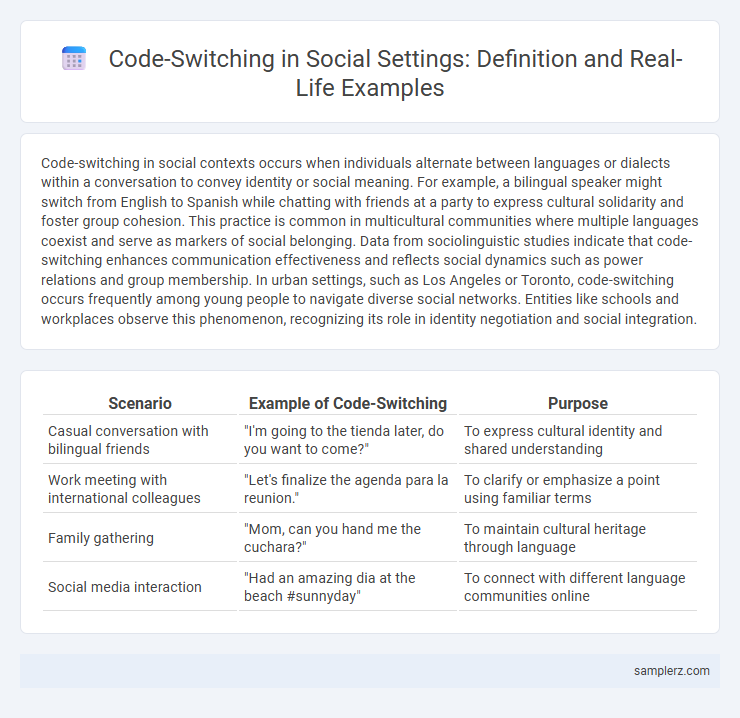Code-switching in social contexts occurs when individuals alternate between languages or dialects within a conversation to convey identity or social meaning. For example, a bilingual speaker might switch from English to Spanish while chatting with friends at a party to express cultural solidarity and foster group cohesion. This practice is common in multicultural communities where multiple languages coexist and serve as markers of social belonging. Data from sociolinguistic studies indicate that code-switching enhances communication effectiveness and reflects social dynamics such as power relations and group membership. In urban settings, such as Los Angeles or Toronto, code-switching occurs frequently among young people to navigate diverse social networks. Entities like schools and workplaces observe this phenomenon, recognizing its role in identity negotiation and social integration.
Table of Comparison
| Scenario | Example of Code-Switching | Purpose |
|---|---|---|
| Casual conversation with bilingual friends | "I'm going to the tienda later, do you want to come?" | To express cultural identity and shared understanding |
| Work meeting with international colleagues | "Let's finalize the agenda para la reunion." | To clarify or emphasize a point using familiar terms |
| Family gathering | "Mom, can you hand me the cuchara?" | To maintain cultural heritage through language |
| Social media interaction | "Had an amazing dia at the beach #sunnyday" | To connect with different language communities online |
Everyday Code-Switching in Multilingual Communities
Everyday code-switching in multilingual communities often occurs during casual conversations where speakers alternate between languages to express cultural identity and convey nuanced meanings. For example, a bilingual Spanish-English speaker might say, "I'm going to la tienda to buy some groceries," blending English structure with a Spanish noun to maintain social bonds. This linguistic practice reflects the dynamic interaction of language and social identity within diverse community settings.
Code-Switching Among Friends: Casual Social Interactions
Code-switching among friends frequently occurs in casual social interactions where individuals alternate between languages or dialects to express identity, humor, or solidarity. This linguistic practice enhances group cohesion and reflects shared cultural backgrounds, often blending informal slang with standard language. Such dynamic language shifts serve as a powerful social tool for reinforcing friendships and navigating social nuances.
Family Gatherings: Navigating Languages at Home
Family gatherings often showcase code-switching as members alternate between languages to express cultural identity and foster inclusivity. This linguistic practice strengthens bonds by allowing older generations to share traditions while younger members incorporate contemporary slang. Code-switching at home navigates diverse communication styles, reinforcing both heritage and social connection.
Code-Switching in Online Social Networks
Code-switching in online social networks often involves alternating between languages or dialects within posts or comments to convey identity, group membership, or emotional nuance. Users may switch from formal language in professional groups to informal slang or emojis when interacting with close friends, enhancing social bonding. Algorithms on platforms like Twitter and Facebook increasingly recognize and adapt to these linguistic shifts, improving content personalization and user engagement.
Balancing Formality: Workplace Social Events
At workplace social events, employees often engage in code-switching by shifting between formal language used during meetings and more casual speech with colleagues. This balancing act helps maintain professionalism while fostering camaraderie and approachability. Such linguistic flexibility reinforces social cohesion and effective communication within diverse organizational cultures.
Identity Expression Through Code-Switching
Code-switching serves as a powerful tool for identity expression within social interactions, enabling individuals to navigate cultural boundaries and assert their multifaceted identities. For instance, bilingual speakers often switch between languages or dialects to signal group membership, social status, or cultural heritage in diverse social settings. This linguistic flexibility not only reflects personal identity but also facilitates social cohesion and community belonging.
Social Media Posts: Mixing Languages for Effect
Social media posts often exemplify code-switching by blending multiple languages within a single message to engage diverse audiences and convey nuanced cultural identities. Influencers and users mix languages like English and Spanish or Hindi and English to create relatable, dynamic content that resonates across linguistic boundaries. This linguistic strategy enhances social connectivity and strengthens online community bonds by reflecting authentic bicultural experiences.
Code-Switching at Cultural Festivals and Events
Code-switching at cultural festivals and events manifests when individuals alternate between languages or dialects to connect with diverse audiences, enhancing cultural expression and inclusivity. This linguistic shift facilitates communication across groups, reflecting identities and shared heritage within multicultural gatherings. Code-switching here not only preserves linguistic diversity but also promotes social cohesion during celebrations like Dia de los Muertos or Lunar New Year festivals.
Peer Influence and Adolescent Code-Switching
Adolescents often engage in code-switching to align with peer group norms, shifting between languages or dialects based on social context. Peer influence plays a critical role in this linguistic adaptation, as young individuals adjust their speech to gain acceptance and foster social bonds within diverse groups. This dynamic exemplifies how code-switching functions as a social tool for identity negotiation and group membership among teenagers.
Humor and Playfulness in Social Code-Switching
Code-switching in social contexts often enhances humor and playfulness by blending languages or dialects to create witty remarks or punchlines that resonate with diverse audiences. For instance, a bilingual speaker might switch between English and Spanish within a joke to amplify comedic timing and cultural relevance. This linguistic blending not only entertains but also strengthens social bonds by highlighting shared cultural knowledge.

example of code-switching in social Infographic
 samplerz.com
samplerz.com